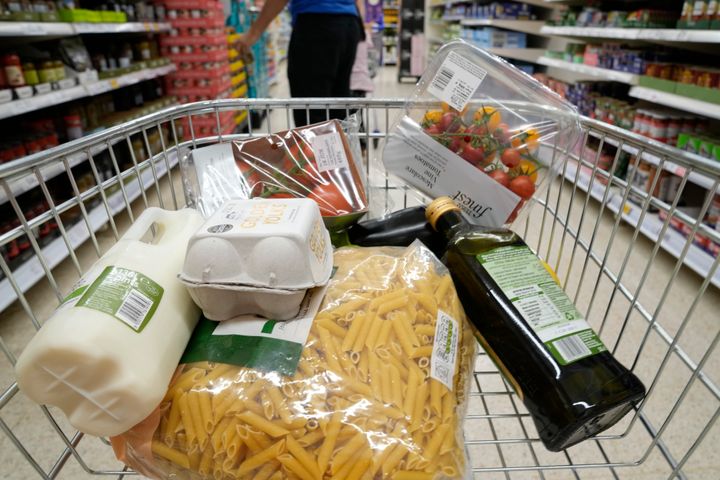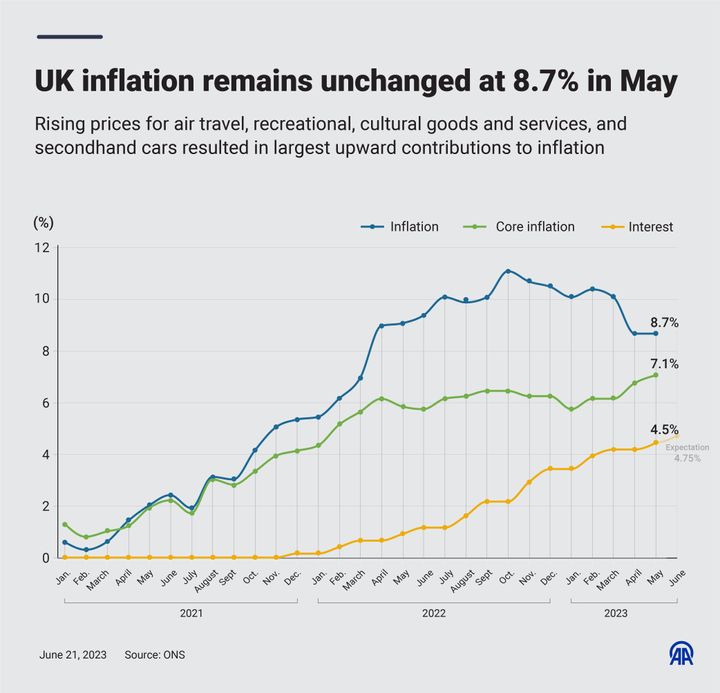
The UK has an inflation problem. Officials had hoped the rising cost of goods and services would have been brought to heel by now, as soaring energy costs fuelled by the war in Ukraine have cooled.
But, on Wednesday, its downward trajectory stalled and alarm bells started ringing.
The Office for National Statistics said inflation, as measured by the consumer price index, held steady at 8.7 per cent in the year to May. Expectations were that the rate would fall a to 8.4 per cent.
And there was more. Britain’s measure of underlying inflation that excludes volatile items, such as energy and food, took investors by surprise by accelerating for a second month in a row in May, hitting 7.1 per cent, up from 6.8 per cent in April. Higher core inflation is seen as a sign that price growth is more likely to remain persistently high.

It looks certain that the independent Bank of England will raise the cost of borrowing again on Thursday for the 13th month in a row – the only question is whether it’s by 0.25 percentage points, or a symbolic half percentage point to 5%.
Don’t other countries have inflation under control?
Britain’s inflation rate has stayed far above price growth in the US and elsewhere in Europe. Although 8.7% is down from a peak of 11.1% last October, it leaves the UK with the highest inflation rate among the G7 advanced economies. By comparison, inflation stood at 4% in the US and 6.1% across the 20 EU countries that use the euro currency.
Last week, the Federal Reserve – America’s equivalent of the Bank of England – ended a 15-month streak of hiking interest rates, a pause that currently seems highly unlikely in the UK.
So why?
The surging cost of food
Britain has had western Europe’s highest rate of inflation for food, with prices up more than 18 per cent over the past year, down only slightly from a recent peak of more than 19 per cent, the highest since 1977.
Freak weather has affected crops around the world, pushing up prices for many countries. But Britain is the world’s third largest net importer of food and drink, according to the Food and Agriculture Organisation of the United Nations – behind only China and Japan – leaving it particularly exposed.
Industry data published on Tuesday showed British grocery inflation eased slightly for the third month in a row in June.
Bank of England governor Andrew Bailey said last month that British food producers may have locked in higher costs than the central bank had anticipated, explaining some of its underestimate of inflation.
Heavy reliance on natural gas
Britain is highly reliant on imported gas to generate electricity, exposing it to the full force of the surge in gas prices last year after Russia’s invasion of Ukraine.
The way Britain regulates energy prices for domestic and business users – it announces changes to maximum tariffs on a quarterly basis – means that international price rises are slower to push up inflation than in many other countries but falls are also slower to feed through into bills for users.
Brexit
Exiting the European Union and its single market at the start of 2021 has started to have an impact. Although an agreement between the UK and the bloc allows largely tariff-free trade in goods, there are barriers to exports and imports in the form of paperwork which have caused delays and higher costs.
Meanwhile, the end of free movement of workers from EU countries has contributed to an acute shortage of staff for many employers, pushing up wages and ultimately prices for consumers.
Bank of England decision-making
Some economists think the Bank, which is tasked with keeping inflation at around 2%, was too slow in starting to raise interest rates and is now playing catch-up.
Its own monetary policy committee rate-setter member, Chaterine Mann, said in February that the Bank should have started raising interest rates earlier (“a greater degree of front-loading” was needed) and is now paying the price.
